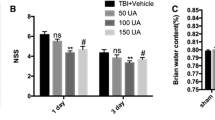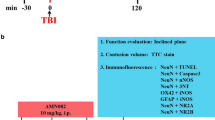Abstract
Edaravone is a novel free radical scavenger used clinically in patients with acute cerebral infarction; however, it has not been assessed in traumatic brain injury (TBI). We investigated the effects of edaravone on cerebral function and morphology following TBI. Rats received TBI with a pneumatic controlled injury device. Edaravone (3 mg/kg) or physiological saline was administered intravenously following TBI. Numbers of 8-OHdG-, 4-HNE-, and ssDNA-positive cells around the damaged area after TBI were significantly decreased in the edaravone group compared with the saline group (P < 0.01). There was a significant increase in neuronal cell number and improvement in cerebral dysfunction after TBI in the edaravone group compared with the saline group (P < 0.01). Edaravone administration following TBI inhibited free radical-induced neuronal degeneration and apoptotic cell death around the damaged area. In summary, edaravone treatment improved cerebral dysfunction following TBI, suggesting its potential as an effective clinical therapy.







Similar content being viewed by others
References
Kontos HA, George E (1985) Brown memorial lecture. Oxygen radicals in cerebral vascular injury. Circ Res 57:508–516
Clausen F, Lundqvist H, Ekmark S, Lewen A, Ebendal T, Hillered L (2004) Oxygen free radical-dependent activation of extracellular signal-regulated kinase mediates apoptosis-like cell death after traumatic brain injury. J Neurotrauma 21:1168–1182
Hall ED, Braughler JM (1989) Central nervous system trauma and stroke. II. Physiological and pharmacological evidence for involvement of oxygen radicals and lipid peroxidation. Free Radic Biol Med 6:303–313
Chan PH, Fishman RA, Longar S, Chen S, Yu A (1985) Cellular and molecular effects of polyunsaturated fatty acids in brain ischemia and injury. Prog Brain Res 63:227–235
Lee EJ, Lee MY, Chen HY, Hsu YS, Wu TS, Chen ST, Chang GL (2005) Melatonin attenuates gray and white matter damage in a mouse model of transient focal cerebral ischemia. J Pineal Res 38:42–52
Chirumamilla S, Sun D, Bullock MR, Colello RJ (2002) Traumatic brain injury induced cell proliferation in the adult mammalian central nervous system. J Neurotrauma 19:693–703
Rice AC, Khaldi A, Harvey HB, Salman NJ, White F, Fillmore H, Bullock MR (2003) Proliferation and neuronal differentiation of mitotically active cells following traumatic brain injury. Exp Neurol 183:406–417
Azbill RD, Mu X, Bruce-Keller AJ, Mattson MP, Springer JE (1997) Impaired mitochondrial function, oxidative stress and altered antioxidant enzyme activities following traumatic spinal cord injury. Brain Res 765:283–290
Kawamata T, Katayama Y, Hovda DA, Yoshino A, Becker DP (1995) Lactate accumulation following concussive brain injury: the role of ionic fluxes induced by excitatory amino acids. Brain Res 674:196–204
Xiong Y, Gu Q, Peterson PL, Muizelaar JP, Lee CP (1997) Mitochondrial dysfunction and calcium perturbation induced by traumatic brain injury. J Neurotrauma 14:23–34
Arai T, Nonogawa M, Makino K, Endo N, Mori H, Miyoshi T, Yamashita K, Sasada M, Kakuyama M, Fukuda K (2008) The radical scavenger edaravone (3-methyl-1-phenyl-2-pyrazolin-5-one) reacts with a pterin derivative and produces a cytotoxic substance that induces intracellular reactive oxygen species generation and cell death. J Pharmacol Exp Ther 324:529–538
Nishi H, Watanabe T, Sakurai H, Yuki S, Ishibashi A (1989) Effect of MCI-186 on brain edema in rats. Stroke 20:1236–1240
Yamamoto T, Yuki S, Watanabe T, Mitsuka M, Saito KI, Kogure K (1997) Delayed neuronal death prevented by inhibition of increased hydroxyl radical formation in a transient cerebral ischemia. Brain Res 762:240–242
Mizuno A, Umemura K, Nakashima M (1998) Inhibitory effect of MCI-186, a free radical scavenger, on cerebral ischemia following rat middle cerebral artery occlusion. Gen Pharmacol 30:575–578
Wu T, Ding XS, Wang W, Wu J (2006) MCI-186 (3-methyl-1-phenyl-2-pyrazolin-5-one) attenuated simulated ischemia/reperfusion injury in cultured rat hippocampal cells. Biol Pharm Bull 29:1613–1617
Dohi K, Satoh K, Mihara Y, Nakamura S, Miyake Y, Ohtaki H, Nakamachi T, Yoshikawa T, Shioda S, Aruga T (2006) Alkoxyl radical-scavenging activity of edaravone in patients with traumatic brain injury. J Neurotrauma 23:1591–1599
Itoh T, Satou T, Hashimoto S, Ito H (2005) Isolation of neural stem cells from damaged rat cerebral cortex after TBI. Neuroreport 16:1687–1691
Itoh T, Satou T, Hashimoto S, Ito H (2007) Immature and mature neurons coexist among glial scars after rat traumatic brain injury. Neurol Res 29:734–742
Watanabe T, Yuki S, Egawa M, Nishi H (1994) Protective effects of MCI-186 on cerebral ischemia: possible involvement of free radical scavenging and antioxidant actions. J Pharmacol Exp Ther 268:1597–1604
Itoh T, Satou T, Nishida S, Tsubaki M, Hashimoto S, Ito H (2009) Improvement of cerebral function by anti-amyloid precursor protein antibody infusion after traumatic brain injury in rats. Mol Cell Biochem 324:191–199
Elvander E, Schott PA, Sandin J, Bjelke B, Kehr J, Yoshitake T, Ogren SO (2004) Intraseptal muscarinic ligands and galanin: influence on hippocampal acetylcholine and cognition. Neuroscience 126:541–557
Takizawa Y, Miyazawa T, Nonoyama S, Goto Y, Itoh M (2009) Edaravone inhibits DNA peroxidation and neuronal cell death in neonatal hypoxic–ischemic encephalopathy model rat. Pediatr Res 65:636–641
Wang X, Karlsson JO, Zhu C, Bahr BA, Hagberg H, Blomgren K (2001) Caspase-3 activation after neonatal rat cerebral hypoxia–ischemia. Biol Neonate 79:172–179
Weissman L, de Souza-Pinto NC, Stevnsner T, Bohr VA (2007) DNA repair, mitochondria, and neurodegeneration. Neuroscience 145:1318–1329
Zhang N, Komine-Kobayashi M, Tanaka R, Liu M, Mizuno Y, Urabe T (2005) Edaravone reduces early accumulation of oxidative products and sequential inflammatory responses after transient focal ischemia in mice brain. Stroke 36:2220–2225
Han N, Ding SJ, Wu T, Zhu YL (2008) Correlation of free radical level and apoptosis after intracerebral hemorrhage in rats. Neurosci Bull 24:351–358
Sugawara T, Noshita N, Lewen A, Gasche Y, Ferrand-Drake M, Fujimura M, Morita-Fujimura Y, Chan PH (2002) Overexpression of copper/zinc superoxide dismutase in transgenic rats protects vulnerable neurons against ischemic damage by blocking the mitochondrial pathway of caspase activation. J Neurosci 22:209–217
Irving EA, Bamford M (2002) Role of mitogen- and stress-activated kinases in ischemic injury. J Cereb Blood Flow Metab 22:631–647
Yasuoka N, Nakajima W, Ishida A, Takada G (2004) Neuroprotection of edaravone on hypoxic–ischemic brain injury in neonatal rats. Brain Res Dev Brain Res 151:129–139
Walton KM, DiRocco R, Bartlett BA, Koury E, Marcy VR, Jarvis B, Schaefer EM, Bhat RV (1998) Activation of p38MAPK in microglia after ischemia. J Neurochem 70:1764–1767
Tsuji M, Inanami O, Kuwabara M (2000) Neuroprotective effect of alpha-phenyl-N-tert--butylnitrone in gerbil hippocampus is mediated by the mitogen-activated protein kinase pathway and heat shock proteins. Neurosci Lett 282:41–44
Wen J, Watanabe K, Ma M, Yamaguchi K, Tachikawa H, Kodama M, Aizawa Y (2006) Edaravone inhibits JNK-c-Jun pathway and restores anti-oxidative defense after ischemia-reperfusion injury in aged rats. Biol Pharm Bull 29:713–718
Niyaz M, Numakawa T, Matsuki Y, Kumamaru E, Adachi N, Kitazawa H, Kunugi H, Kudo M (2007) MCI-186 prevents brain tissue from neuronal damage in cerebral infarction through the activation of intracellular signaling. J Neurosci Res 85:2933–2942
Xiong Y, Mahmood A, Lu D, Qu C, Kazmi H, Goussev A, Zhang ZG, Noguchi CT, Schallert T, Chopp M (2008) Histological and functional outcomes after traumatic brain injury in mice null for the erythropoietin receptor in the central nervous system. Brain Res 1230:247–257
Acknowledgment
The authors thank Mari Machino for technical assistance.
Author information
Authors and Affiliations
Corresponding author
Rights and permissions
About this article
Cite this article
Itoh, T., Satou, T., Nishida, S. et al. Edaravone Protects Against Apoptotic Neuronal Cell Death and Improves Cerebral Function After Traumatic Brain Injury in Rats. Neurochem Res 35, 348–355 (2010). https://doi.org/10.1007/s11064-009-0061-2
Received:
Accepted:
Published:
Issue Date:
DOI: https://doi.org/10.1007/s11064-009-0061-2




